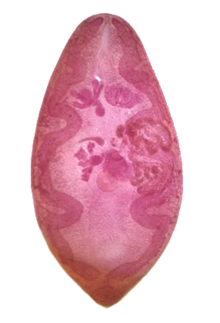Paragonimus westermani
| Paragonimus westermani | |
|---|---|
 |
|
| An adult specimen stained with carmine | |
| Scientific classification | |
| Kingdom: | Animalia |
| Phylum: | Platyhelminthes |
| Class: | Trematoda |
| Order: | Plagiorchiida |
| Family: | Troglotrematidae |
| Genus: | Paragonimus |
| Species: | P. westermani |
| Binomial name | |
|
Paragonimus westermani Kerbert, 1878 |
|
| Subspecies | |
|
P. westermani filipinus |
|
P. westermani filipinus
P. westermani ichunencis
P. westermani japonicus
P. westermani westermani
Paragonimus westermani is the major species of lung fluke that infects humans, causing paragonimiasis. The species sometimes is called the Japanese Lung fluke or Oriental Lung fluke. Human infections are most common in eastern Asia and in South America. Paragonimus westermani was discovered when two Bengal tigers died of paragonimiasis in zoos in Europe in 1878. Several years later Infections in humans were recognised in Formosa.
Paragonimiasis is a food-borne parasitic infection caused by the lung fluke. It may cause a sub-acute to chronic inflammatory disease of the lung. It is one of the most familiar lung flukes with the widest geographical range. It was discovered by Coenraad Kerbert (1849-1927) in 1878.
More than 30 species of trematodes (flukes) of the genus Paragonimus have been reported to infect animals and humans. Among the more than 10 species reported to infect humans, the most common is Paragonimus westermani, the oriental lung fluke.
In size, shape, and color, Paragonimus westermani resembles a coffee bean when alive. Adult worms are 7.5 mm to 12 mm long and 4 mm to 6 mm wide. The thickness ranges from 3.5 mm to 5 mm. The skin of the worm (tegument) is thickly covered with scalelike spines. The oral and ventral suckers are similar in size, with the latter placed slightly pre-equatorially. The excretory bladder extends from the posterior end to the pharynx. The lobed testes are adjacent from each other located at the posterior end, and the lobed ovaries are off-centered near the center of the worm (slightly postacetabular). The uterus is located in a tight coil to the right of the acetabulum, which is connected, to the vas deferens. The vitelline glands, which produce the yolk for the eggs, are widespread in the lateral field from the pharynx to the posterior end. Inspection of the tegumental spines and shape of the metacercariae may distinguish between the 30-odd species of Paragonimus spp. but the distinction is sufficiently difficult to justify suspicion that many of the described species are synonyms.
...
Wikipedia
